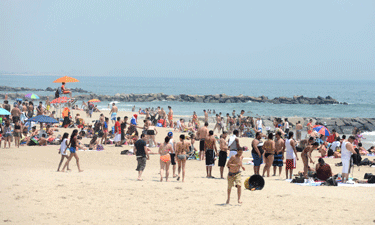 New York City’s coastline is longer than those of Miami, Boston, Los Angeles and San Francisco combined, and roughly 155 miles of it is comprised of publicly accessible parks and open spaces, managed by NYC Parks. Building along the waterfront has been a legacy of the past decade in our city’s history, and the benefits of access to the water reach beyond recreation — the coastline provides enormous educational and ecological benefits, and it offers a sense of openness to New Yorkers that is a welcome respite from an often-crowded city life. New destinations like Brooklyn Bridge Park attract 125,000 visitors on an average summer weekend and from Memorial Day through Labor Day our beloved beaches see upwards of 18 million visitors.
New York City’s coastline is longer than those of Miami, Boston, Los Angeles and San Francisco combined, and roughly 155 miles of it is comprised of publicly accessible parks and open spaces, managed by NYC Parks. Building along the waterfront has been a legacy of the past decade in our city’s history, and the benefits of access to the water reach beyond recreation — the coastline provides enormous educational and ecological benefits, and it offers a sense of openness to New Yorkers that is a welcome respite from an often-crowded city life. New destinations like Brooklyn Bridge Park attract 125,000 visitors on an average summer weekend and from Memorial Day through Labor Day our beloved beaches see upwards of 18 million visitors.
With outstanding numbers like this, it’s certainly a testament to our staff that the rate of drowning in New York City is far below the national average, but we know that even a single drowning is one too many. These tragedies can be avoided and we are committed to taking every step possible to help keep our children safe from harm in our city’s parks, beaches and waterfronts.
In the summer of 1936, Parks Commissioner Robert Moses opened 11 Olympic-sized outdoor pools throughout the five boroughs, accommodating more than 40,000 bathers each. At a time when most people swam in the river to beat the heat, these pools offered a clean, controlled alternative and they had a huge impact on safety: in 1934 there were 450 drowning incidents in the city and by 1939 that number had decreased by about a third.
Back then, Moses found an equitable solution to the issue of water safety by providing widespread access to pools. These days, we’re taking Moses’ lead with a comprehensive, three-pronged initiative that brings swimming education and water safety measures to communities that need it most.
Swim for Life
In partnership with the city’s top providers of swim instruction, we’re teaching second-grade students vital water safety lessons as a class, during the school day. Swim for Life runs for three 10-week sessions during which students learn water entry, breath control and submerging, buoyancy, and treading. In our experience, second graders have proved the perfect candidates for this program — they are generally old enough to stand in the water and young enough that they have not developed body-image issues. As part of the program, students are also eligible for free annual memberships to NYC Parks’ recreation centers to practice their skills.
Since it was launched in 2011, more than 35,000 second graders have attended Swim for Life classes, and our goal is to one day reach all schools through this program.
Water Safety at Coastal Parks
It’s our responsibility to ensure that safety is built into the infrastructure of our waterfront parks. Last summer, we completed a city-wide review of all of our boat launches and implemented a number of safety enhancements, including the installation of self-closing gates, solar-powered emergency call boxes, life rings and throw lines. We also increased signage and instituted a weekly inspection protocol of all of these elements by our enforcement staff.
Public Outreach
After being struck by Hurricane Sandy in October 2012, much of New York City’s boardwalk and oceanfront properties were damaged or destroyed. The city was able to open its beaches on time in the summer of 2013, and these days, we’re rebuilding to protect ourselves against the next storm. Since the steady pace of rebuilding our beaches has affected access, any closure notices or changes to beach operations are now being updated each day on our website. We are also exploring ways to partner with the Metropolitan Transportation Authority, the entity that runs the city’s subways, to incorporate beach-closure information into their station announcements, as well as with the city’s Department of Health and Office of Emergency Management to share these notices on the web. Our hope is that by better informing beach goers of places where swimming is allowed, we’ll offer a safe alternative to illegal swimming at unsupervised beaches.
May marks National Water Safety month, and as we look forward to opening New York City’s beaches at the end of the month, we hope that park systems across the country will join us in the effort to make sure our summers are as safe and fun as possible.
Mitchell J. Silver, FAICP, is Commissioner of the New York City Department of Parks and Recreation.

